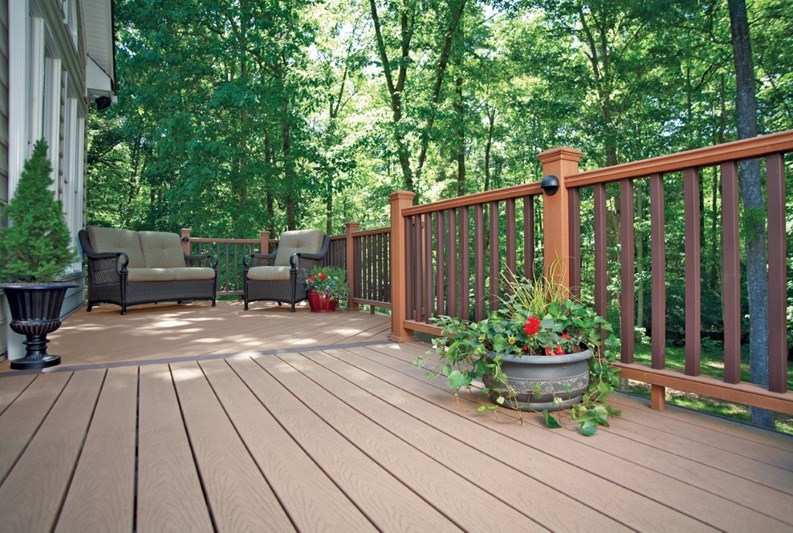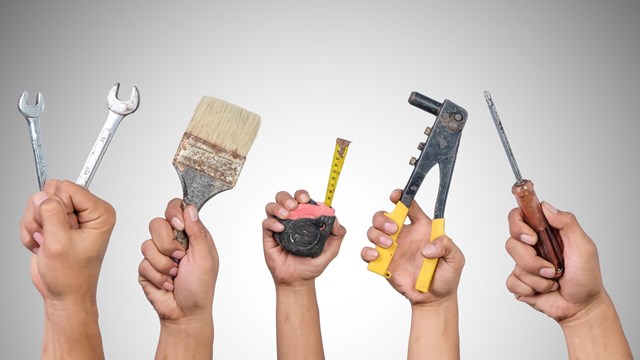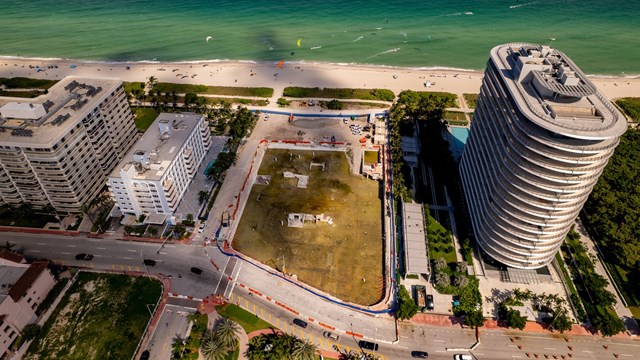There may be a distinct charm to weathered clapboard and rustic-looking wooden siding, but from a practical perspective, that pleasing patina is really the sign of decay and deterioration. For an HOA board, it’s also the sign of major expense to come.
The advent of modern building materials has done wonders for rehabs of old buildings, where maintenance—or lack of it—is a very real issue. Condo associations and real estate investors alike are benefiting from the introduction of a new array of options when it comes to siding and decking materials, the old standbys being replaced by a new generation of choices that promise longer life spans with less maintenance.
These days, when existing porches or decks begin to deteriorate, they are being replaced with plain, pressure-treated lumber or longer-lasting composite materials. When old-time wood siding fails, it’s being replaced by vinyl siding or even fiber cement, both of which can mimic wood to a precise degree. Because decks and siding have to be replaced so often, it is in these areas that condominiums can realize the greatest savings—or losses, if they choose the wrong material or fall victim to shoddy installation.
Installation Problems
Materials and installation methods for decks and siding, whether tried and true or new and trendy, fall in and out of favor, for any number of reasons. HOAs can help their bottom line enormously while looking sharp—as long as they work with their contractor to choose the best product for their needs, and to see that it’s installed properly. Choose a lesser material or fumble the install, and the condo can be nickel-and-dimed to death by maintenance costs while falling short in the curb appeal department.
An alert and proactive contractor can be an HOA’s first line of defense against siding-related mishaps. Lenny Capriglione, operations manager of Aiese & Associates Contracting in Matawan recalls a project in which an association intended to simply paint their exterior cedar siding—until it was discovered that the majority of the wood was damaged. Painting over it would have sealed in the decay and allowed it to spread unchecked until it let in moisture—which could lead to mold contamination, health problems for residents, and major structural damage over time.
Ultimately, the cedar was removed and replaced with a synthetic siding with insulation behind it. Capriglione explains, “The [replacement] project lasted for about a year and a half, and it cost around $4 million. But they’re [now] saving money on all their energy bills, and they don’t have that maintenance of painting the whole complex every three years. They have a maintenance free exterior, and the place looks beautiful.”
The experience of that particular association is not unique, and illustrates how choices of materials and installation for decks and siding can impact maintenance plans for decades. This example is echoed by many in the industry, as building methods and materials changed dramatically during the 1970s and ’80s, just when condominium projects took off in popularity throughout New Jersey.
Decked Out
One of the things that makes suburban condos and HOAs such desirable living spaces is the ability for unit owners to have their own outdoor space in the form of a deck or patio area. Appealing as they are, outdoor structures require a certain level of maintenance and care to remain safe and attractive—and today, thanks to a new generation of building materials, that’s easier than ever.
While wood still dominates as the material of choice for decks, alternatives like composite lumber and polyvinyl chloride (PVC) have gained a great many fans among both contractors and homeowners.
Composite lumber can be a combination of tiny wood particles or recycled materials bonded together with polymers or plastics. The Trex brand is an industry standard, but others that have tested well include Veranda, Trimax and Deck Loc.
PVC has been available since the mid-1980s, but in recent years, PVC and similar synthetics have gained momentum in the construction field. Vinyl has five times the tensile strength of wood and four times the flexibility. It’s nearly maintenance-free, impervious to weather, and will never require painting. Vinyl products will also not peel, rot or discolor, and are easy to install—which cuts down on billable man-hours—and can even be molded to mimic wood grain.
According to industry pros, PVC has gained a great deal of popularity in recent years because of its durability and very low maintenance requirements—aside from periodic power washing, it’s almost maintenance free. According to Brook Copeland, vice president of commercial accounts with All County Exteriors in Lakewood, New Jersey, “the benefits to the homeowner or the association are that its life cycle is much longer. You don’t have the hazards of cracking and chipping as you would with a wood product over time. With wood products you’ll have to stain them and maintain them to preserve them in the original state from when first installed. With PVC lumbers, you will not have those maintenance issues.”
PVC material can be left unfinished, or with a color-matched permanent finish. In addition, some PVC lumbers, are made to withstand in-house traffic and the tell signs of wear and tear. “On top of all the benefits on the list, some of them are stain and scratch resistant,” says Copeland. “So unlike with wood, you can movea chair across [your deck] with out any concerns that you’ll gouge it.”
At installation, PVC costs slightly more than regular wood decking, says Copeland, which costs approximately $35 per square foot, in comparison to composite decking which could run about $55 per square foot. However, the low- or no-maintenance aspect of PVC can save associations on the cost of replacements and repairs.
According to industry figures, a very approximate base cost for a 15-by-12-foot smooth slab patio that doesn’t require removal of preexisting material is roughly $1,600. An equivalent cedar deck might cost around $8,000. A new wood-polymer composite deck runs approximately $7,400, and sealing or painting a deck this size runs between $250 and $750, on average.
The consistent color and shape, uniformity and durability make engineered-wood alternatives an attractive option for many consumers. According to Copeland, the newest trend to reach the Northeast is fiber cement wood, a mixture of wood fibers and Portland cement. “They are manufactured in the same widths as horizontal flat wood siding. They come in a range of exposures—from four-inch exposures and eight-inch to nine-inch exposures—so you can replicate the look of wood, and again from a maintenance prospective, it’s less to maintain. It comes from the factory painted and with a 15-year paint warranty. That’s the big seller, he says.”
That doesn’t mean that real wood is done for when it comes to decks, however. It depends on what woods are used, and how. There are New Jersey state requirements governing the use of wood in construction projects.
The cheapest wood allowed is cedar, which costs nearly half as much as a more solid, longer-lasting wood like spruce. With economy comes penalty, however. The life span of cedar—approximately 12 years—is roughly half that of spruce, according to one fence and deck contractor. “Any fence over 12 years old is probably starting to go, and after 15 years, it will be shot,” he says. “And that’s because the builder probably used cedar, since that’s all that is required by law.”
For his part, David H. Vahlsing, an engineer for Becht Engineering Company, Inc., headquartered in Liberty Corner says that wood—or at least the look of wood—is still the preferred choice when it comes to decks for purely aesthetic reasons. “We favor use of wood or wood-like materials when feasible,” he says, adding that nearly all commercial lumber for outdoor products is pressure-treated these days, which endows the wood with chemical properties that enable it to repel both water and pests, like termites. Wood must also generally be stained and sealed, both to maximize its aesthetic appeal, and to protect it from moisture and other damage.
Regardless of material and finish, proper construction of a deck is crucial to its soundness, safety, and longevity. “A good foundation is essential,” says Vahlsing. “If you’re using wood posts [to support a deck], they need to be placed well below the freeze line. And don’t pour concrete around the base—that makes it extremely difficult to remove them in 20 years when the wood is rotted out. The concrete ring actually traps water and promotes rot, unless care is taken to seal the joint between the wood and concrete on a regular basis.”
While a homeowner’s personal preference might be for an all-wood patio, other considerations have to be taken into account before the decision is made. “If raising above grade is a problem,” cautions Vahlsing, “if you have to match with doors or steps, you may need to go with concrete to remain flush with the grade, which isn’t acceptable for a wooden deck.”
Most reputable decking contractors give potential customers a price breakdown, along with maintenance and replacement cost information on each option. From there, the HOA administrators and their management can make an informed decision about what’s best for their particular community.
Delayed Maintenance Cycles
Many condo projects dating from the building boom of the 1980s are now experiencing failures and subsequent replacement of siding and decking. But it didn’t have to be this way, says Timothy Wentzell, P.E. and a principal in Connecticut Property Engineering in South Windsor, Connecticut. “You can see 15-year-old condos with rotted siding while 100-year-old homes have the same [original] wood siding… and it looks great.”
He attributes problems in fairly new construction to lagging maintenance cycles. “What often happened with brand new associations is that they didn’t get into the maintenance cycle for painting exterior wood surfaces until ten years or more went by,” Wentzell says. And he adds that vertical siding will curl and twist unless you keep it up, from day one with paint or other protective coatings. He notes that wood siding is traditional and association managers and boards choose to stay with it “because they like the look.”
Wentzell agrees that with siding and decking, water penetration is the main thing boards and managers should look out for. To check for sub-par siding installation, he advises probing around window frames where leakage is the biggest problem. “If you have vinyl,” he warns, “the major downfall is that it covers up sins. A whole wall could be rotted underneath before you would notice any evidence,” while problems with wood are more visible right away.
Wentzell’s company specializes in helping associations with building and feasibility studies for maintenance and capital projects. Convincing owners about the important investment they have in siding and decks can be a challenge, he states, because “people typically purchased a condo and were only concerned about the inside… They forget that they own a piece of the outside.”
Marie Auger is a freelance writer and a frequent contributor to New England Condominium magazine, a Yale Robbins’ publication.







Leave a Comment